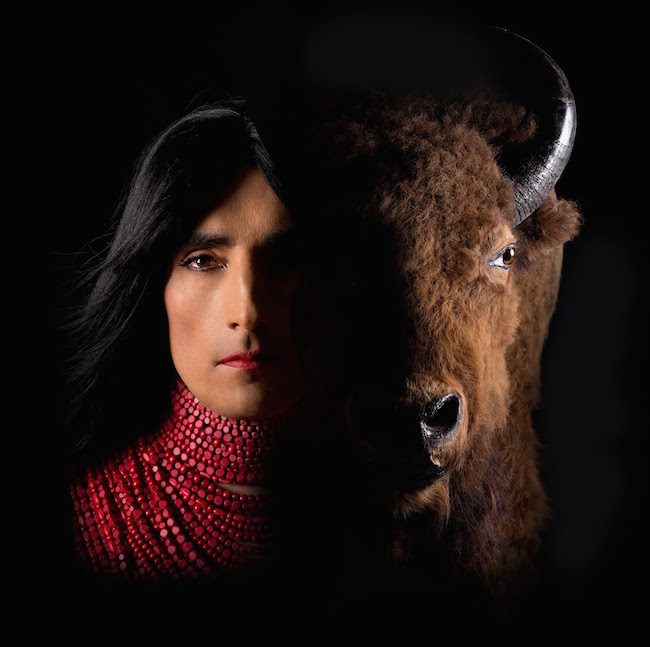Kent Monkman is a Canadian artist of Cree ancestry who works in the fields of painting, video, performance and installation art. His installation at Toronto’s Gardiner Museum, The Rise and Fall of Civilization (October 15, 2015 — January 10, 2016) draws on Monkman’s fascination with history, not only the history of his own culture, but also on the shifting, subjective way history is read by those who come after.
Setting the tone for this dialogue, according to Monkman, is the way Rise and Fall resembles a natural history diorama. The realistic cliff, the buffalo models and the mannequin, Miss Chief Eagle Testikle (the artist’s alter ego), all look like they’ve come charging out of a display case at the Smithsonian. Monkman told Murray Whyte of the Toronto Star:
“That museum convention, of the natural history diorama, was a big inspiration for this one,” says Monkman who, at 49, has the lean, youthful appearance of someone much younger – a necessity for his propensity to appear scantily-clad in drag (more on that in a moment).
“Inspiration” might be a bit too polite: In Monkman’s world, conventions are made to be transgressed, and his drag effigy, Miss Chief Eagle Testikle, perched atop the cliff, is his patron goddess of such departures. Museums, and all their prescribed rules of display, are his Trojan horse: He works as an anthropologist of anthropology, unpacking official histories to insert his own revisions. Using the museum’s own language to subvert an official agenda is clever, but asks a vital question: Who owns history, and which version can we trust?
Monkman, whose Aboriginal heritage has taught him all he needs to know about oppression, doubles-down on it nonetheless: As both Aboriginal and gay, he’s known exclusions and biases on two fronts all his adult life. Choosing neither to cower nor to rage, he’s built his path back to the centre of the cultural conversation by very different means.
The cliff is a reference to an old hunting tactic in which herds would be stampeded over a cliff. After the buffalo fell to their deaths, the tribe could collect the meat. The buffalo are at their most lifelike at the top of the cliff, but they become abstractions the further away they get. One has crashed into a pile of bone porcelain. Others, those furthest away from the cliff, turn into mere line drawings, a reference to a work by Picasso. Some vital element is being leached from the animals as they travel across time and the creatures closest to us look as distant from the real thing as images on a cave wall. The muscular bulk of these beasts, their hair, the sound of thudding hooves, the smell of dust and musk— not a scrap of it has come down to us. We have an empty space contained within the shape of a buffalo. That’s it. Perhaps even that line drawing will disintegrate one day.
Less abstract than the decay of meaning, than the increase of noise to signal across time, is the literal historic reading of the work. From the Gardiner Museum:
The smashed ceramics at the base of the cliff reference the build up of bones often found at buffalo jumps, as well as the history of Indigenous ceramics found at sites across North America. At the Ulm Pishkun Buffalo Jump, one of the largest in the world, a layer of compacted bones thirteen feet deep was found. This compacted bone, much like the bone ash used to make bone china, fills the space below the cliffs and tells the story of thousands of years of sustainable hunting, layer by layer, before the quick destruction of the bison by the European settlers. The layers of sediment in the rock face and the compacted bone and ceramics at the foot of the cliff allude to the layers of civilization, from the ancient to the present. The plunging bison that leap from the cliff and morph into modernist bulls and back into ancient rock drawings function as a metaphor for the inevitable flow of history.
Monkman, according to his biography, has had solo exhibitions at numerous Canadian museums including the Montreal Museum of Fine Art, the Museum of Contemporary Canadian Art in Toronto, the Winnipeg Art Gallery, and the Art Gallery of Hamilton. He has participated in various international group exhibitions including: The American West, at Compton Verney, in Warwickshire, England, Remember Humanity at Witte de With, Rotterdam, the 2010 Sydney Biennale, My Winnipeg at Maison Rouge, Paris, and Oh Canada!, MASS MOCA. Monkman has created site specific performances at the McMichael Canadian Art Collection, The Royal Ontario Museum, and at Compton Verney, he has also made Super 8 versions of these performances which he calls “Colonial Art Space Interventions.” His award-winning short film and video works have been screened at various national and international festivals, including the 2007 and 2008 Berlinale, and the 2007 Toronto International Film Festival. His work is represented in numerous public and private collections including the National Gallery of Canada, Montreal Museum of Fine Arts, Museum London, The Glenbow Museum, The Museum of Contemporary Canadian Art, The Mackenzie Art Gallery, the Art Gallery of Ontario, the Smithsonian’s National Museum of the American Indian and the Vancouver Art Gallery. He is represented by Pierre-François Ouellette art contemporain in Montreal and Trepanier Baer Gallery in Calgary.
What do you think of Kent Monkman’s subversion of the natural history diorama? Let us know in the comments.









Kent Monkman is also the subject of a chapter in the new Bloomsbury press book, “Sloppy Craft.” I find the connection between his work and the ethos of sloppiness forced, but there it is nonetheless.